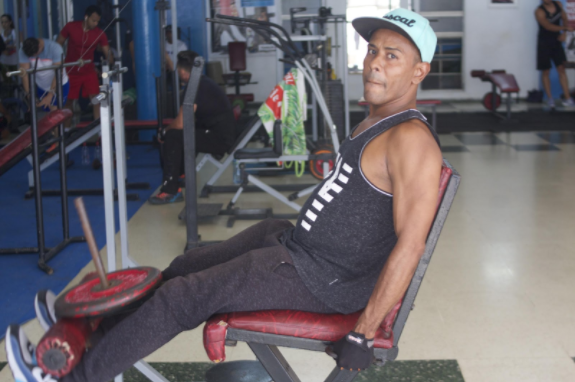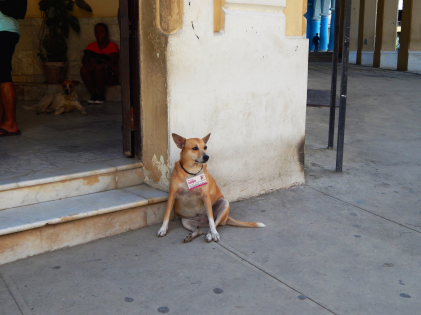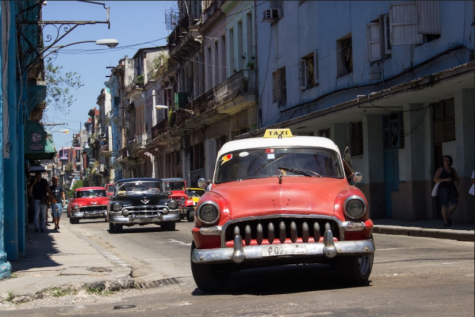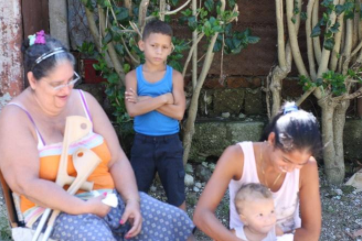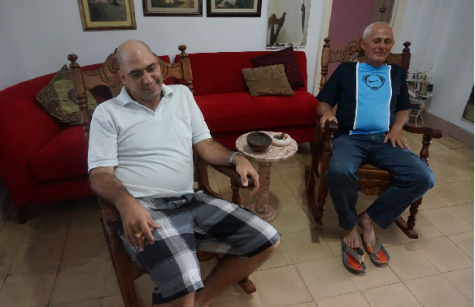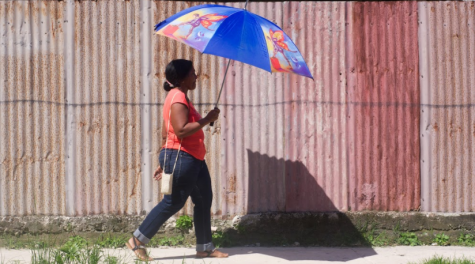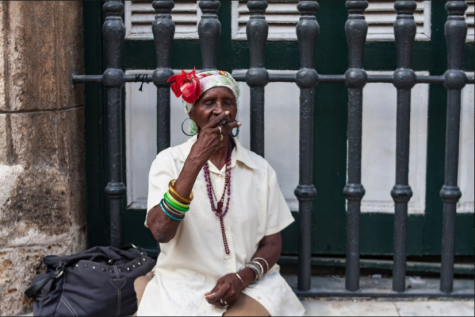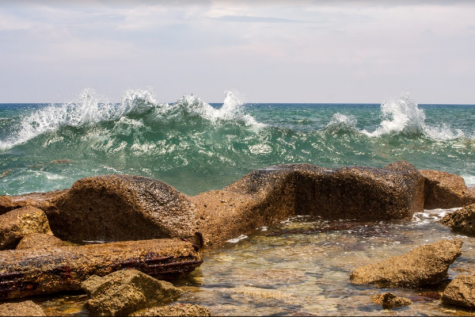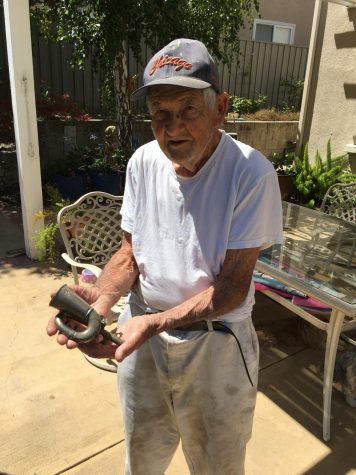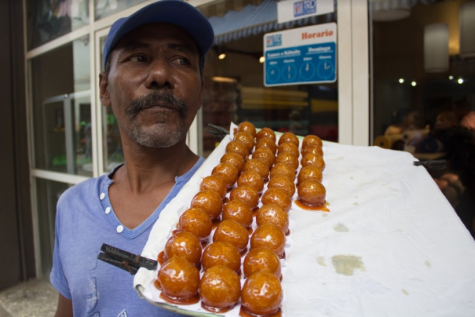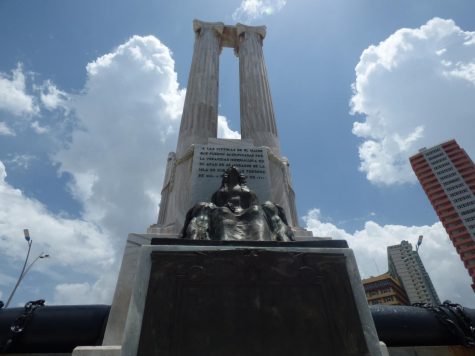Habana strength
August 29, 2017
Sweat began to drip after spending all but five minutes inside Osorio’s Gym. There was no form of air conditioning besides a slight breeze making its way through the front entrance. “Two CUC,” Osorio replied when asked how much it was to work out at his gym.
It looked like a basement garage of some sort, underneath a house, presumably his. The cardio section consisted of four stationary bikes and a cast iron elliptical that squeaked each time you pressed down on it with your foot. For being one of the nicer gyms in Habana, it was kind of disappointing to see the aerobic section rather bare until it dawned on me that I skip cardio day anyway.
While in the gym, the owner would walk around and supervise and help everyone that needed it. There was no release of liability forms to fill out, so it may have been necessary to do the extra chaperoning after all. Something as little as a release form, that is so common to have in any business relating to physical activity back in the States, didn’t even exist here. Does the owner worry about a potential lawsuit? Is business booming? Or is it a struggle to get members to consistently come in? All of these questions drove my curiosity in knowing the rest of the challenges that professionals go through working in the fitness and health industry in the country of Cuba.
The first gym visited was located in central Habana on Calzada Y M street. It looked to be inside a parking garage as you had to walk down a steep driveway, then make a sharp right to see a small window attached to a room that looked like a dungeon with poor circulation. Opening the doors, you could see the light leading to the gateway of gym heaven. I have never seen so many weights shoved into a tiny room like this since I last went to visit San Jose State’s weight room. All joking aside, there were portraits of famous American bodybuilders that filled the walls with intense lighting that dimmed the room enough to create an illusion of a chilling atmosphere. There was a trainer there by the name of Ricardo who was seen training a woman on the hack squat machine, cheering her on as she struggled to complete her last few reps.
When it looked like he was heading for a break, I quickly approached him and asked what it was like being a personal trainer at this gym. “I like it here,” he replied, “I’ve worked here for two years.” Getting more personal, I asked how many clients he typically trains in a week and he explained, “I don’t know, it’s hard to get clients here. I might train two or three people in a week but not many people have money to spend on training.” As a personal trainer myself, I cringed at the idea of not being able to use my services to make a living due to the financial burden of the community, but this was the reality that Ricardo and others were facing in the industry that they are in. “I try to train as many people as I can, but most can’t continue for a long time because of money,” he went on. “I have to lower the cost of training in order to make something to feed my family.” This was interesting knowing that you are forced to compromise your services in order to put food on the table. Lack of income already seemed apparent in this industry we call fitness and that didn’t seem like the only issue.
As a personal trainer myself, I cringed at the idea of not being able to use my services to make a living due to the financial burden of the community, but this was the reality that Ricardo and others were facing in the industry that they are in. “I try to train as many people as I can, but most can’t continue for a long time because of money,” he went on. “I have to lower the cost of training in order to make something to feed my family.” This was interesting knowing that you are forced to compromise your services in order to put food on the table. Lack of income already seemed apparent in this industry we call fitness and that didn’t seem like the only issue.
“I try to train as many people as I can, but most can’t continue for a long time because of money,” he went on. “I have to lower the cost of training in order to make something to feed my family.” This was interesting knowing that you are forced to compromise your services in order to put food on the table. Lack of income already seemed apparent in this industry we call fitness and that didn’t seem like the only issue.
Besides the numerous outside playing stations equipped with a set of monkey bars and horizontal iron bars secured to the dirt, it is up to the locals to invest in their own gym. When talking with Osorio, the owner of his own gym, he had a humble and quiet demeanor that you would have never thought you were talking to former two-time bodybuilding champion of Cuba. His facial expressions were intense yet warm when asking for help.
“There are no certifications for personal trainers here,” he replied when asked about the criteria of the profession. “I received my degree in physical culture and sports” from The University of the Sciences of the Physical Culture and Sport “Manuel Fajardo” (UCCFD), a well respected school dedicated to superior research performance on athletes and physical activity worldwide, which is located adjacent from the Cuban Center for Sports Scientific Research (CIDC).
“I was a boxer for many years and I went to school to become a teacher of boxing until I grew a passion for bodybuilding,” Osorio replied when asked how he got into the fitness industry. “This gym has been developing for over twenty years into what it is now,” he explained with a concerned look. “Most of the equipment you see in there, I built myself, by searching through waste for parts…. some things I had to buy and needed assistance on the construction of the machines but it was an independent journey.” You could see the pride shining off this man as he stood in front of his gym tall, starting with nothing and turning it into something. With a gaze of confidence in his eyes, the question was brought up on how business was at the gym. “It’s good, the industry is becoming more popular, and more people want to start their own gyms and work out.”
You could see the pride shining off this man as he stood in front of his gym tall, starting with nothing and turning it into something. With a gaze of confidence in his eyes, the question was brought up on how business was at the gym. “It’s good, the industry is becoming more popular, and more people want to start their own gyms and work out.”
This was promising to hear, even with the lack of resources provided to the people to make it in this industry. “I don’t do my job for the money but for the reward of helping others,” he said. “My love for my job is payment enough.” Talk about eating a slice of humble pie coming from a nation where we value quantity over quality. I asked the man how much he would charge someone like me to train with him twice a week and he replied, “2 CUC a day.” which was shockingly cheap and within my budget. “I’ll be back tomorrow to work out,” I told the translator, Lionel, to share with Osorio, as he grinned and nodded his head in approval.
Arriving at the gym, Osorio looked engaged with other members in the gym. Unfortunately, there was no translator on hand so I decided to start working out and to hopefully get his attention later on to share some advice from trainer to trainer. It was upper-body day and seeing all the equipment for chest and back was an exciting feeling, as I knew it would give me a chance to really feel how Cubans here work out. Nothing looked super out of the ordinary; it was just very dated equipment and knowing that there have been many who have worked out with these same weights, including champions of fitness like Osorio, brought joy and motivation to go hard in the workout.
Doing some seated rows was on the list as the handles were two long rusted vertical iron bars that had no specific area on where to place your hands. It was a long reach to the bars from the seat so I grabbed the top portion and started lifting. I was shortly approached by Osorio, who explained the different ways to hold the bars and how it would affect different muscle groups. The way I was holding the bars was predominantly focused on targeting the biceps, which is the anterior portion of the arm attached from the shoulder down to the elbow, and he explained that grasping from a lower position would put more emphasis on my rhomboids and trapezius muscles, which are the upper muscles of the back inferior to the neck. Of course, this was all said in Spanish, but I felt very aware of what he was saying; maybe because we had a trainer bond that connected us together that was spoken universally. It was pleasing to know that we trainers were more similar than different.
Osorio was also generous enough to show me a workout program that he tailored for himself in developing explosiveness in the legs. “Monday and Friday I work on developing speed.” When discussing philosophies of training he talked of the different styles he incorporates when training others as well as himself. “I mix boxing, crossfit and weightlifting all together, that gives a good foundation to build from.”
His influences were based on parts of Western culture through reading books and magazines as well as the elders whom he learned from. “I don’t have any specific role models that I look up to but I respect everyone’s philosophies and try to learn from them.” From a gentleman who’s been in the fitness industry for over twenty years, he was humble and wise, which gave an explanation as to how he has been so successful in this line of work. The next day I was sore from back to front and I loved every minute of it, satisfied of having this feeling that I hadn’t felt since leaving America.
Fortunately, it didn’t end there, as there were more gyms to visit and more people to talk to. Street 17 y E was the next order of business where it was said that it was the biggest gym in all of Habana. After getting lost for close to an hour, a gym was spotted randomly in an alleyway that looked like you needed to be a local to know where this gym was located. It looked like there was a secret password needed just to enter the gym, as the door had a small hole near the top for people to keep an eye out for who was entering. Luckily the door was open and no further assistance was needed. There was a lady sitting down near the door who looked to be the manager on duty. “¿Está bien tomar fotos del gimnasio?” asking for permission to take photos of the gym the lady replied, “Si, esta bien,” Quickly the camera came out and the canon started firing. Action shots of the members working out; bright colorful dumbbells; Zumba class going on; a rope hanging from the ceiling. Wait, a rope?! Haven’t seen one of those since watching a movie back from the eighties (I wasn’t even born yet). Watching people attempt to climb up this rope was a sight to see as there was no safety material needed, like gloves to prevent skin burns, as they climbed up close to twenty feet and slapped the ceiling before making their way back down. A long rough rope hanging down was a breath of fresh air to see, as it was symbolic of the tough resilient Cuban culture that has been on display since arriving.
Quickly the camera came out and the Canon started firing. Action shots of the members working out; bright colorful dumbbells; Zumba class going on; a rope hanging from the ceiling. Wait, a rope?! Haven’t seen one of those since watching a movie back from the 80s. Watching people attempt to climb up this rope was a sight to see, as there was no safety material like gloves to prevent skin burns. They climbed up close to twenty feet and slapped the ceiling before making their way back down. A long rough rope hanging down was a breath of fresh air to see, as it was symbolic of the tough resilient Cuban culture that had been on display since arriving.
After taking hundreds of photos it was time to look for the person in charge who looked like they knew what they were doing. When spotting a man who looked to be coaching a gentleman on the proper technique of front squats I knew we had found our guy. Alo was the name of the trainer and he looked eager to talk with us. He shared his personal background of how he got into fitness at a young age and through years of experience, he became the top trainer (and only trainer) of the gym, 17 & E, named after the address. He confessed to having no credentials, such as a four-year degree, to prove his credibility besides years of experience on his belt that had to be trusted. He explained that he had a friend who was also in the fitness and health industry as well as a trainer and physical therapist (PT) that he offered for us to get in contact with, so we took him up on the offer. “Come back tomorrow at 2” Alo explained. Knowing that you just booked an appointment to interview a Cuban PT was exciting to the point that I made sure not to be late.
He explained that he had a friend who was also in the fitness and health industry as well as a trainer and physical therapist (PT) that he offered for us to get in contact with, so we took him up on the offer. “Come back tomorrow at 2,” Alo explained. Knowing that you just booked an appointment to interview a Cuban PT was exciting to the point that I made sure not to be late.
Flashing forward to the next day, Alo arrived and brought the special guest with him as well. “Hello, I’m Kenny,” the PT said, introducing himself. This man was tall, dark and handsome with big strong hands, and was he ever a talker. He was more excited to talk with us than Alo was the day prior. He spoke of receiving his degree in physical therapy from UCCFD. “I was an honor student when I attended,” he explained, “not because I was more intelligent but because I had passion for the subject.” Being able to relate, I asked Kenny of the challenges he faces in the industry of fitness and health. “There is no money in this industry,” he uttered with an expression of disbelief, “not as a trainer or a therapist. I wrote a letter to Castro asking for more money in my profession in order to make a living, but I was denied”. “I ripped my degree in half” elaborating on the actions he took next, “I hung the two halves on my wall as a symbol of my accomplishment that is seen as worthless to my government.”
Being able to relate, I asked Kenny of the challenges he faces in the industry of fitness and health. “There is no money in this industry,” he uttered with an expression of disbelief, “not as a trainer or a therapist. I wrote a letter to Castro asking for more money in my profession in order to make a living, but I was denied. I ripped my degree in half,” elaborating on the actions he took next, “I hung the two halves on my wall as a symbol of my accomplishment that is seen as worthless to my government.”
Hearing that statement felt like a sunny day all of a sudden turning into gloominess by a storm of clouds occupying the sky. And yet, there was still a stream of sunlight shining down as Kenny continued on. “I don’t let it affect me,” he stated with optimism. “Now I work at a clinic every day and help people with their injuries for no cost… I don’t see this as work because it is something I love to do, I have a gift of helping people.” Chills went down my spine hearing such a powerful message from a kind soul.
“Most of my time goes towards the clinic and I train when I find time,” he said about his daily routine. “At night I am a security guard. I make more money in three days as a security guard than a month’s work of physical therapy.” Putting the two salaries in perspective was unbelievable as there is nearly no comparison on the income scale. Knowing a government that won’t invest in a field with great value is disheartening, but instead of abandoning his passion, Kenny decided to figure out a way to make a living as well as give back to his community.
With a lack of resources, income and support from the government, the fitness industry has been under complete independence by the professionals in the field. Fitness enthusiasts were forced to build their own equipment from scratch and use broken down machines from the 80s in order to get a pump. The dedication is so astonishing that it lends the perspective of being grateful for any environment you encounter and making the most of it. Coming from America, I’ve noticed a lot of things being taken for granted as a trainer compared to a country where it is hard enough for a trainer to put food on the table. Though we live in an entirely different political society, compared to Cuba, the fitness industry has been alive and well for decades where it is almost impossible not to find a local gym within your city or town.
There is such an abundance of resources and support in the States that it is questionable on why we are one of the most obese nations in the world. Even if the fitness professionals are paid more handsomely in America, that does not mean that we are superior to another nation such as Cuba. Cuba is known for their great educational system with many athletes originating from the country. As explained earlier, they are looking to become pioneers in the industry and respected worldwide. Although this region may not have the best equipment, make the best income or even if there profession isn’t looked on with much value from the government, it does not define them. They still take pride and integrity into their field of work regardless of who is watching.
Fuerza Habana! Habana strength!




